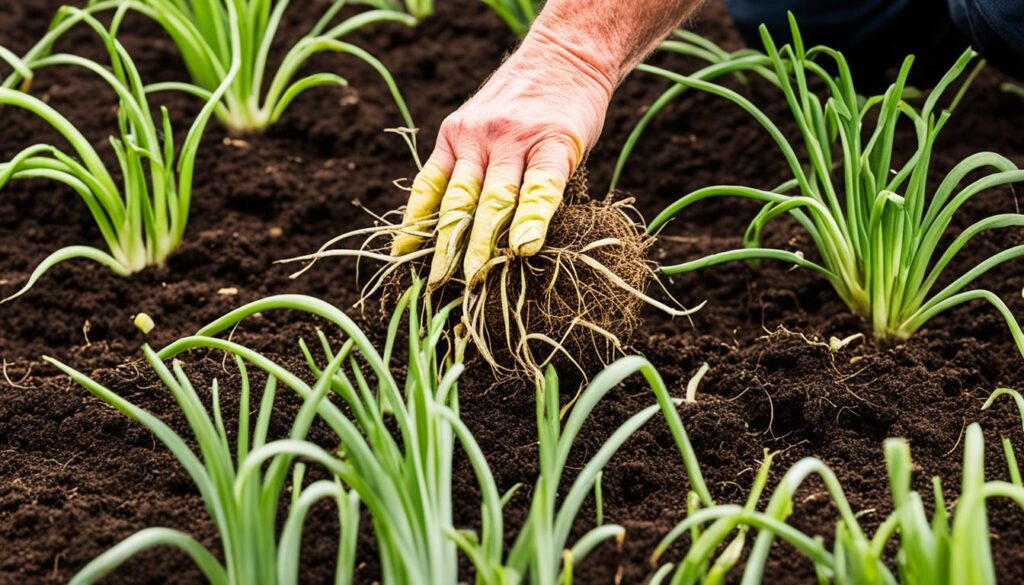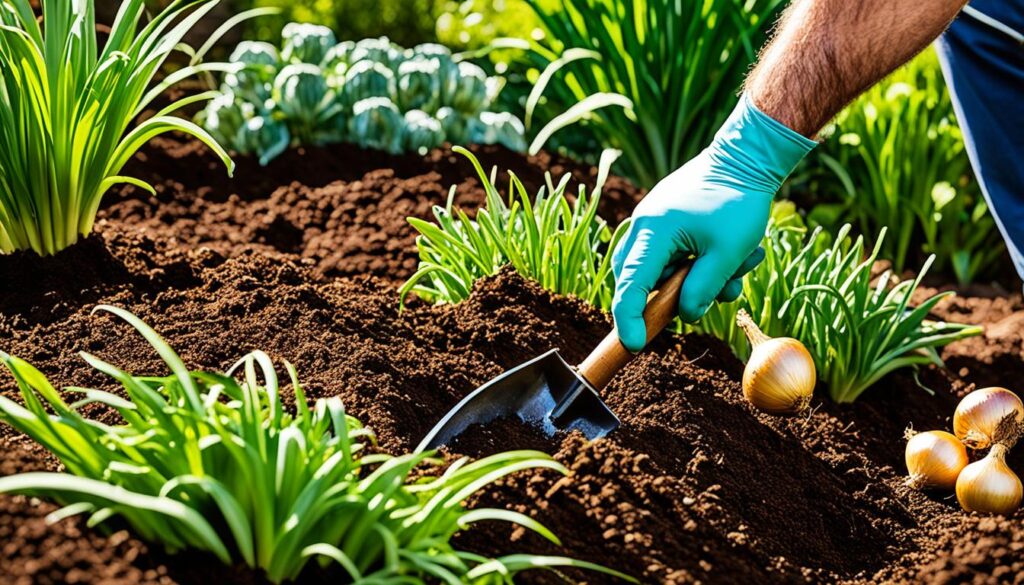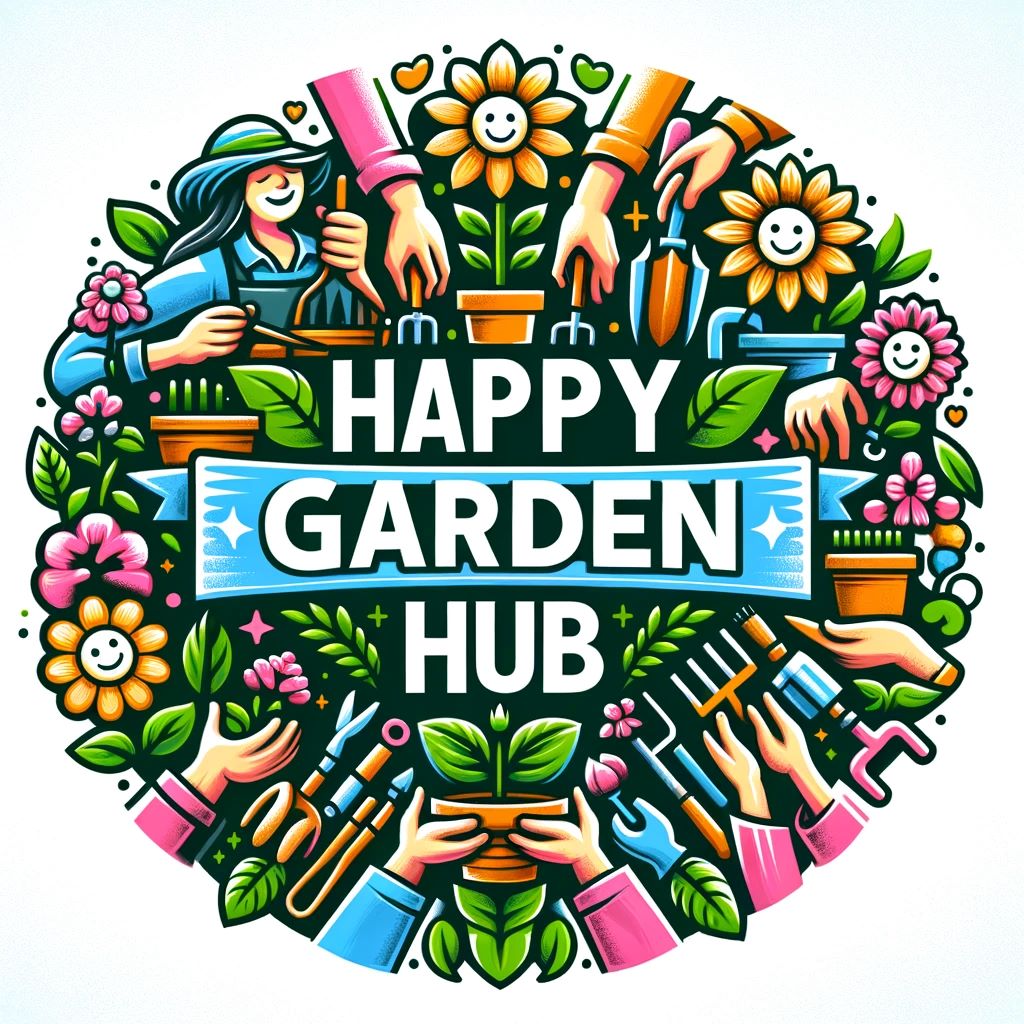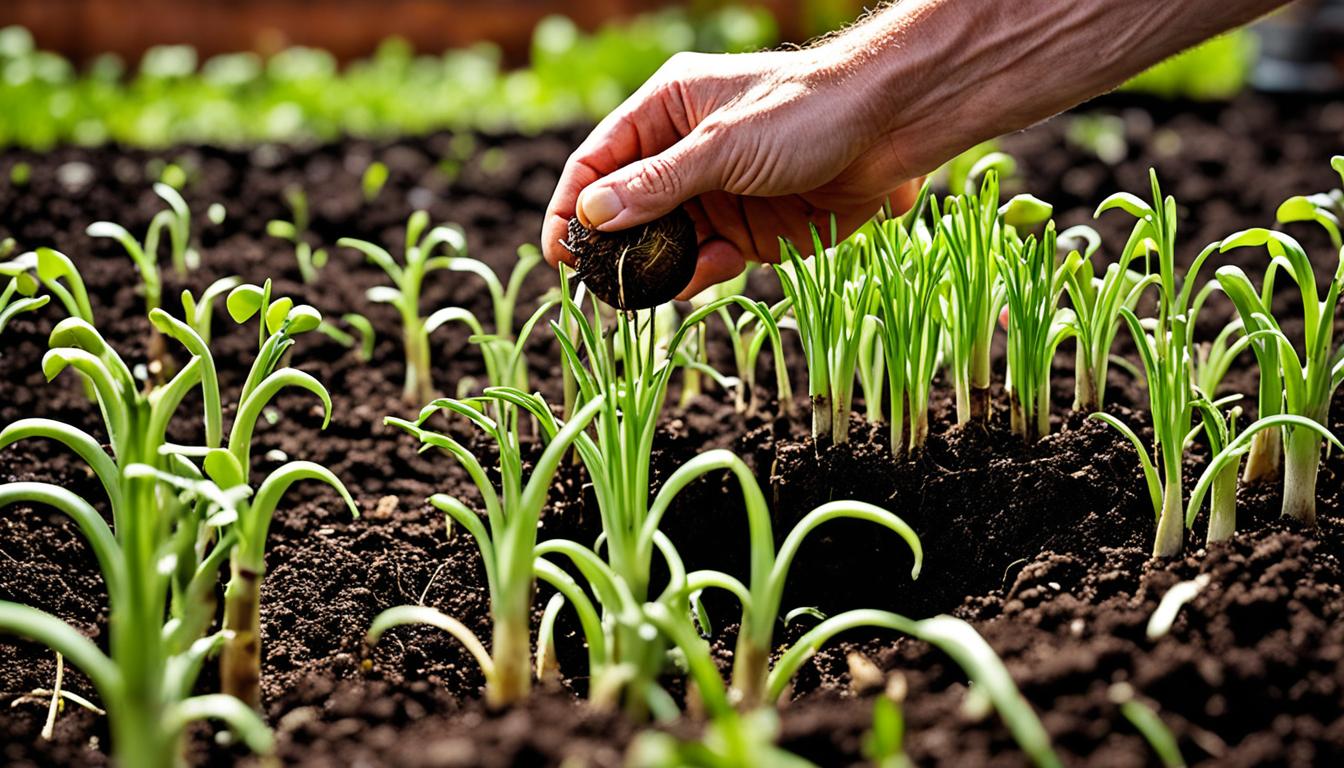This post contains affiliate links.
Have you ever tasted the tangy crunch of a freshly harvested onion straight from your own garden? There’s something truly magical about growing your own food, and onions provide that perfect balance of flavor, versatility, and long storage life that can elevate any dish.
Imagine the satisfaction of watching your onions thrive, from tiny bulbs to robust plants, as you nurture them with care and expertise. Your garden becomes a haven, a place where you can connect with nature and witness the miracle of growth unfold before your eyes.
Whether you’re a seasoned gardener looking to expand your repertoire or a beginner eager to embark on a new adventure, our onion gardening tips will empower you to cultivate a bountiful harvest that will fill your home with the fragrance of success.
So, put on your gardening gloves, grab your trowel, and let’s dive into the world of onion gardening together!
Key Takeaways:
- Onions are a versatile and long-lasting vegetable, making them a popular choice for home gardens.
- With the right techniques, you can cultivate a bountiful harvest of onions in your own backyard.
- Choosing the right planting method, location, and soil is key to successful onion gardening.
- Regular care, including watering, fertilizing, and pest control, is essential for healthy onion growth.
- Harvesting and storing onions properly will ensure months of culinary delight.
Planting Onions: Sets vs. Seeds
When it comes to growing onions, you have two main options: using onion sets or starting from seeds. Let’s explore the pros and cons of each method to help you decide which one is right for you.
Onion Sets
Growing onions with sets offers several advantages:
- Quick maturity: Onion sets are small bulbs that have already gone through the first stages of growth. Planting them means you’re closer to harvesting your onions.
- Higher success rate: Because sets are already partially grown, they have a higher chance of producing healthy, full-sized bulbs.
- Resistance to light freezes: Onion sets can tolerate mild frosts, making them a great choice for early spring or fall planting.
Starting Onions from Seeds
Planting onions from seeds also has its advantages:
- Wide variety: When you start onions from seeds, you have access to a broader selection of onion cultivars. This allows you to experiment with different flavors, sizes, and colors.
- Indoor germination: Starting onions indoors gives you more control over the growing conditions. You can ensure they receive adequate warmth and light for optimal germination.
- Transplanting flexibility: Seeds give you the flexibility to transplant your onions outdoors when the conditions are favorable. This method is especially useful in regions with short growing seasons.
Ultimately, the choice between sets and seeds depends on your climate and preferences. If you’re looking for a quicker harvest and want to simplify the growing process, onion sets are a reliable choice. On the other hand, if you enjoy experimenting with different onion varieties and are willing to put in a bit more effort, starting onions from seeds can be a rewarding experience.
| Onion Plants | Onion Sets | Onion Seeds |
|---|---|---|
| Planting Method | Directly into the ground | Indoor germination and transplanting |
| Time to Harvest | Quicker | Longer |
| Variety | Limited | Wide selection |
| Cold Tolerance | Resistant | Frost-sensitive |
As you can see from the table above, both onion sets and seeds have their unique characteristics. Consider your preferences and gardening goals to make an informed decision. Whichever method you choose, with proper care and attention, you can enjoy a bountiful harvest of delicious, homegrown onions.
Choosing the Right Location and Soil for Onions
Onions are fickle beings, my friend. They thrive in specific conditions and take offense when mistreated. So, if you want to grow the best onions in your garden, pay attention!
First things first, onions are sun worshippers. They need their dose of vitamin D, just like you do. When choosing a spot in your garden, make sure it receives a healthy 6-8 hours of direct sunlight each day. Give those onions a tan they’ll appreciate!
But that’s not all. Onions are picky about their soil too. They like it loose and well-draining—none of that bog-like mess for them. So, if you want to impress your onion pals, prepare the soil accordingly. Add aged manure or compost to improve moisture retention and boost the nutrient content. It’s like giving your onions a luxurious spa treatment!
Now, here’s a secret tip: avoid planting onions in the same spot year after year. Why, you ask? Well, it’s like going to the same restaurant every night—you get bored, and so do the onions. More importantly, it helps prevent the spread of diseases that can ruin your onion party. So, let the onions dance around your garden and spice things up!
The Best Soil for Onions
Okay, let’s summarize the key points for your onion growing success:
- Location: Give your onions a sunny spot, basking in the golden rays for 6-8 hours a day.
- Soil: Treat your onions to loose and well-draining soil. Think fluffy clouds, not murky swamps.
- Preparation: Amp up the soil’s moisture retention and nutrient content by adding aged manure or compost. Your onions will thank you later.
- Variety: Mix it up by planting onions in different spots each year. It keeps the diseases away and adds some excitement to the garden.
Now that you know how to create the best growing conditions for your onions, it’s time to embark on this flavorful journey. Your garden will soon be the envy of all onion lovers!
Proper Planting Techniques for Onions
When it comes to successfully planting onions, it’s important to get your hands a little dirty. Follow these proper planting techniques to ensure your onion bulbs thrive in the soil. And remember, happy onions mean tasty onions!
Bury Them Right
When planting onion sets, bury them at a depth of 1-2 inches in the soil. This gives them enough room to establish their root systems while providing stability. For transplants, space them 1 inch apart, with rows spaced 12-18 inches apart. Allow them some breathing space to grow into delicious, tear-inducing bulbs.
The Pointy Side Up
Don’t confuse your onions. Make sure to plant the bulbs with the pointy end facing upwards. This will help guide their growth towards the surface and prevent them from getting disoriented underground. Remember, onions have enough layers to deal with—let’s not give them extra confusion!
Mulch It Up
Prevent moisture loss and pesky weed invasions by mulching your onion beds with straw. A layer of straw helps retain moisture and keep the soil cool, which onions love. Plus, it gives your garden a charming, rustic touch that even the pickiest rabbits can appreciate.
Nitrogen Boost
Give your onions a head start in bulb development by fertilizing the soil with nitrogen during planting. Nitrogen is like an onion’s multi-vitamin—it helps them grow big and strong. Just a little boost at planting time will set your onions on the path to a future filled with flavorful rings.
Essential Care Tips for Growing Onions
To ensure your onions thrive and reach their full potential, proper care is essential. Here are some essential tips:
- Water your onions regularly, keeping the soil moist but not waterlogged. Onions require consistent moisture to grow properly, but overwatering can lead to rot and diseases.
- Keep an eye out for common onion pests, such as thrips and onion maggots. These pesky critters can damage your onions and hinder their growth. Employ preventative measures like regular inspections and the use of organic pest control solutions.
- Apply nitrogen fertilizer every few weeks until the bulbing process begins. This promotes healthy growth and the development of flavorful bulbs. However, once bulbing starts, cease fertilization to avoid stunted growth and disease susceptibility.
Remember, a little care goes a long way in supporting your onion plants. By following these tips, you’ll be well on your way to a successful onion harvest.

“A well-cared-for onion plant is a happy onion plant that will reward you with a bountiful harvest!”
Different Onion Varieties for Your Garden
When it comes to onion varieties, you have a world of options waiting for you. Each variety brings its own unique flavor and characteristics to the table. Whether you prefer the sweet, mellow taste of a yellow onion or the bold, pungent flavor of a red onion, there’s a variety that’s perfect for you.
Long-day varieties are a great choice for those living in northern latitudes. These onions require longer daylight hours to bulb, making them perfect for areas with extended summers. They tend to have a larger size and a higher sugar content, resulting in a sweeter flavor. Some popular long-day onion varieties include:
- Yellow Sweet Spanish
- Red Wethersfield
Short-day varieties, on the other hand, thrive in southern latitudes where the daylight hours are shorter. These onions bulb faster and have a shorter storage life compared to long-day varieties. Their flavor is often milder and less sweet. If you live in a region with mild winters, short-day varieties are your go-to choice. Consider these short-day onion varieties:
- Stuttgart
When choosing onion varieties for your garden, consider your climate and personal taste preferences. Plant a mix of long-day and short-day varieties to enjoy a range of flavors throughout the year. Experiment with different onion varieties in your recipes to add depth and complexity to your dishes.
Comparing Long-Day and Short-Day Onion Varieties
| Variety | Day Length Preference | Flavor | Size | Storage Life |
|---|---|---|---|---|
| Yellow Sweet Spanish | Long-day | Sweet and mellow | Large | Long |
| Red Wethersfield | Long-day | Bold and robust | Medium | Long |
| Stuttgarter | Short-day | Mild and tangy | Medium | Short |
Harvesting and Storing Onions
Now that your onions have flourished in your garden, it’s time to reap the rewards of your hard work. Harvesting onions at the right time ensures that you enjoy their robust flavors and long storage life. Follow these steps to master the art of harvesting and storing onions:
- Observe the tops: Watch for the telltale signs that your onions are ready for harvest. When the tops turn yellow and start to fall over, it’s a good indication that they are mature and ready to be pulled from the ground.
- Speed up ripening: If you’re eager to harvest your onions a bit sooner, you can expedite the ripening process. Simply bend the tops down or give them a gentle stomp. This action helps divert energy from the foliage to the bulbs, resulting in faster ripening.
- Loosen the soil: Before harvesting, gently loosen the soil around the bulbs with a garden fork or trowel. This step makes it easier to remove the onions without damaging them.
- Pull or dig them out: Carefully pull or dig the onions out of the ground, ensuring that you don’t bruise or injure the bulbs. Use your hands or a garden fork to gently lift them from the soil.
Once you’ve successfully harvested your onions, the next crucial step is curing them. Properly drying and storing onions ensures their long shelf life and quality. Here’s how to do it:
- Drying the onions: After harvesting, allow your onions to dry in a well-ventilated area with good airflow. A cool and dry location, such as a shed or garage, works well. Spread them out on a mesh or wire rack to promote air circulation around the bulbs. Leave the tops attached during this curing process.
- Patiently wait: Let your onions dry for several weeks until the necks are thoroughly dry and the outer skins become papery. This crucial drying period helps seal and preserve the onions, extending their storage life.
- Storage conditions: Once your onions are adequately dried, it’s time to store them for later use. Choose a cool and dry place, such as a basement or pantry, to keep them fresh. Avoid storing onions near potatoes or other vegetables, as they can emit moisture and promote spoilage.

Tips for Storing Onions:
“Always inspect your stored onions periodically and remove any that show signs of decay or disease. One rotten onion can spoil the whole batch!”
Follow these guidelines to maximize the storage life of your onions:
- Avoid moisture: Ensure the storage area is dry to prevent mold or rot from setting in.
- Maintain ventilation: Good air circulation is crucial for onion storage. Store them in a mesh bag, hanging basket, or an open tray.
- Separate rotten onions: If you notice any onions starting to spoil, remove them immediately to prevent the spread of disease to other healthy bulbs.
- Consider temperature: Onions store best at temperatures between 32°F (0°C) and 40°F (4°C). Avoid storing them in the refrigerator, as it can make them soft and affect their flavor.
| Onion Diseases | Cause | Symptoms |
|---|---|---|
| Botrytis Leaf Blight | Fungus (Botrytis squamosa) | Brown spots on the leaves, rotting bulbs |
| Downy Mildew | Fungus (Peronospora destructor) | Purple-gray mold on leaves, stunted growth |
| White Rot | Fungus (Sclerotium cepivorum) | Yellowing leaves, white fluffy mold, smelly bulbs |
Fun Facts and Tips about Onions
Onions are more than just a kitchen staple. They have a long history of being used for their medicinal properties. In fact, in the Middle Ages, onion juice was believed to cure baldness and headaches. While we can’t guarantee that rubbing an onion on your head will bring back hair, it’s fascinating to learn about the traditional uses of this versatile vegetable.
Onions also have some interesting folklore associated with them, particularly when it comes to predicting the weather. According to old wives’ tales, if you cut an onion in half and the inner rings are thick, it’s a sign of a harsh winter ahead. Onions are also believed to be sensitive to daylight, which affects the choice of onion varieties for different regions. So, next time you’re choosing onion seeds or sets, think about the weather patterns in your area!
Did you know that you can grow onions from sprouted bulbs? If you’ve ever left some onions in your pantry for too long, you may have noticed green shoots emerging from the bulbs. Rather than tossing them away, you can plant these sprouted onions in your garden and enjoy a fresh harvest. It’s a fun experiment to try, and who knows, you might end up with a whole new crop of onions!
Onions have also been used in home remedies for various ailments. From soothing bee stings to relieving coughs and colds, this pungent vegetable has a history of being a go-to remedy in many households. While we can’t vouch for the effectiveness of these remedies, it’s intriguing to delve into the onion’s medicinal lore.
| Facts about Onions | Tips for Using Onions |
|---|---|
|
|
Onions are more than just an ingredient in your favorite recipes. They have a rich history, intriguing folklore, and surprising uses beyond the kitchen. Whether you’re curing headaches with onion juice or experimenting with sprouted bulbs in your garden, onions continue to captivate and surprise us. So the next time you’re chopping an onion, take a moment to appreciate all the fun facts and hidden treasures this humble vegetable has to offer!
Tips on Growing Onions from Other Sources
Looking to expand your knowledge on onion gardening? Here are some additional tips and insights from trusted sources that can help you achieve onion-growing success:
“For quicker and more reliable results, consider using either transplants or sets for planting your onions. Transplants provide a head start as they are already partially grown, while sets are small bulbs that mature quickly and have a higher success rate.” – The Garden Journal
Proper spacing and care techniques are crucial for healthy onion plants. Make sure to give each onion bulb enough room to grow by spacing them at least one inch apart. Additionally, pay attention to watering, weeding, and fertilizing your plants to ensure optimal growth and yield. – Onion Grower’s Guide
“Pest and disease control should be a priority to protect your onion crop. Regularly monitor for common onion pests such as thrips and onion maggots, and take appropriate measures to keep them at bay. This may include using organic pest controls or employing protective netting.” – Gardening 101
When selecting onion varieties, consider those that are well-suited for storage. Certain varieties like ‘Red Wethersfield’ and ‘Stuttgarter’ have a longer shelf life, allowing you to enjoy your homegrown onions for months after harvest. Remember to cure your onions properly before storing to enhance their longevity. – The Onion Enthusiast
Recommended Onion Varieties for Storage
| Variety | Description |
|---|---|
| ‘Yellow Sweet Spanish’ | A classic onion variety with a mild and sweet flavor. Ideal for storage and use in various culinary dishes. |
| ‘Red Wethersfield’ | A red onion variety known for its excellent storage capabilities and strong, pungent flavor. Perfect for adding color and depth to your recipes. |
| ‘Stuttgarter’ | A popular yellow onion variety prized for its long storage life and versatility in cooking. Adds a delicious aromatic flavor to dishes. |
Remember to consult reliable sources for additional guidance and onion gardening tips. By incorporating different perspectives, you can tailor your approach and maximize your success as an onion gardener.
Conclusion
Growing onions in your home garden can be a flavor-filled journey that will make your culinary creations pop with deliciousness. By implementing these essential onion gardening tips, you can cultivate a thriving harvest of onions that will keep your kitchen stocked and your taste buds satisfied.
When it comes to onion gardening success, choosing the right planting method is crucial. Whether you opt for onion sets or seeds, consider your climate and preferences. Provide your onion plants with a location that receives ample sunlight and well-draining, loose soil enriched with compost or aged manure.
Remember to give your onions the love and care they need by watering regularly, controlling pests and diseases, and applying nitrogen fertilizer. Come harvest time, keep an eye out for yellowing tops and gently pull or dig the bulbs from the ground. Allow them to dry properly before storing in a cool and dry place for months of onion goodness.
So, put on your gardening gloves, embrace your green thumb, and get ready for a productive onion-growing adventure. With the right knowledge and techniques, you’ll be able to enjoy the satisfying crunch and mouth-watering flavor of homegrown onions in every meal. Happy onion gardening!
FAQ
What are some essential tips for successful onion gardening?
What are the differences between planting onions using sets or seeds?
What type of soil is best for growing onions?
What are the proper planting techniques for onions?
How do I care for growing onions?
What are some popular onion varieties to choose from?
When are onions ready for harvest and how should they be stored?
Are there any fun facts and tips about onions?
Where can I find more tips on growing onions?
What are some essential onion gardening tips to remember?
Source Links
- https://www.almanac.com/plant/onion-sets
- https://www.goodhousekeeping.com/home/gardening/a20705738/how-to-grow-onions/
- https://www.gardenbetty.com/how-to-harvest-and-cure-your-onion-crop/
This post contains affiliate links.

